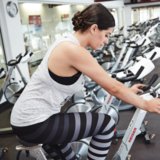
Spin class can be downright intimidating. The padded shorts and cycling shoes many people wear to class can make it feel intense and exclusive, and the loud music and even louder instructor help raise the scare factor. While an indoor cycling class is an intense cardio workout – one 45-minute class can burn upward of 500 calories! – it doesn’t have to be scary.
What to Wear
Since you will be sweating, choose moisture-wicking clothes with good breathability. Unless you have the option to rent cycling shoes from the studio, regular athletic shoes are fine to use; there’s no need to invest in cycling shoes until you know the class is for you. In addition to what you’re wearing, also bring water and a towel to class. To dress like a pro, take a look at these gear essentials from Allie Fell, an instructor at SoulCycle.
When to Arrive
If the gym or studio doesn’t have an online reservation system, get there early to reserve a bike; the sign-up sheet is usually put out an hour before class starts (either at the front desk or hanging outside the classroom). Insider tip: during peak times, the list starts to fill up about 20 minutes before class starts.
Besides booking your bike ahead of time, arrive to class 10-15 minutes early. This will allow you time to talk to the instructor and get help setting up your bike. If the instructor isn’t there yet, don’t be afraid to ask someone around you for help. Not having your bike set up properly can result in lower back, knee, or shoulder pain. Before class begins, be sure to ask if there is any special jargon or hand positions you should know about – many boutique studios use there own names for moves and hand positions.
Related: Mistakes You’re Making in Spin Class
Class Rundown
There’s high-energy music blasting that keeps you moving – and motivated! – for the entire class, and be prepared to sweat. The instructor will guide you through the workout, telling you when to increase or lower resistance, pedal faster, and rise or sit from your saddle. You’ll be guided through climbs, sprints, and muscle isolations with intermittent lower-resistance pedaling during cruising periods. Like any successful workout, keeping your core engaged is key. If you need to alter the instructions to make it through the class, go ahead and slightly decrease the tension or pedal slower. Remember that you are ultimately in control. As with anything new, know your limits, and as time goes on, you’ll be sure to build up your strength and endurance!
Source: Pop Sugar

